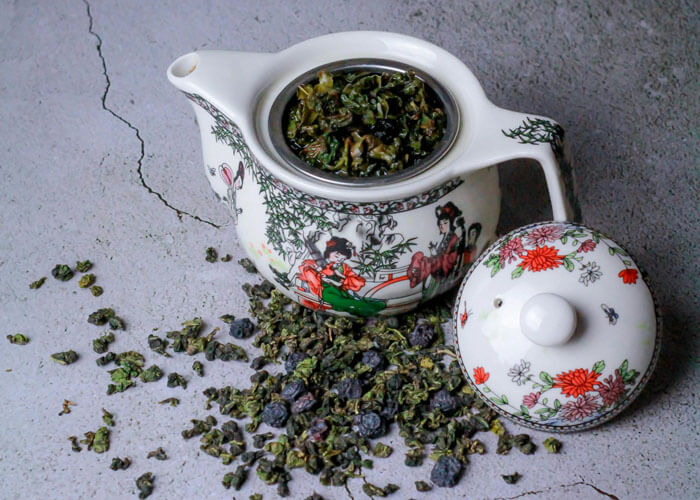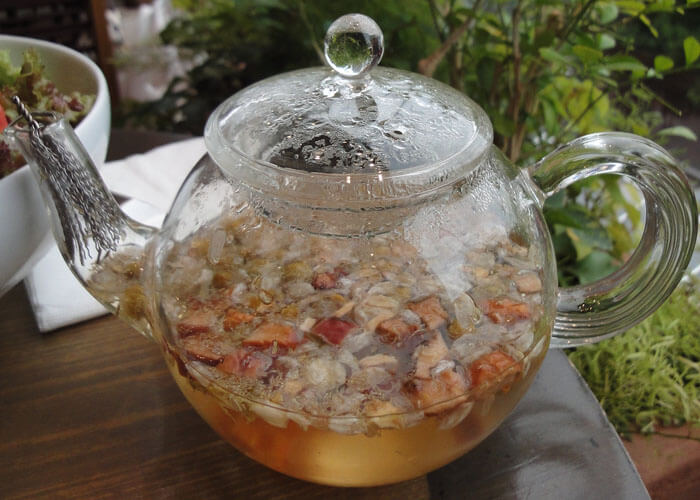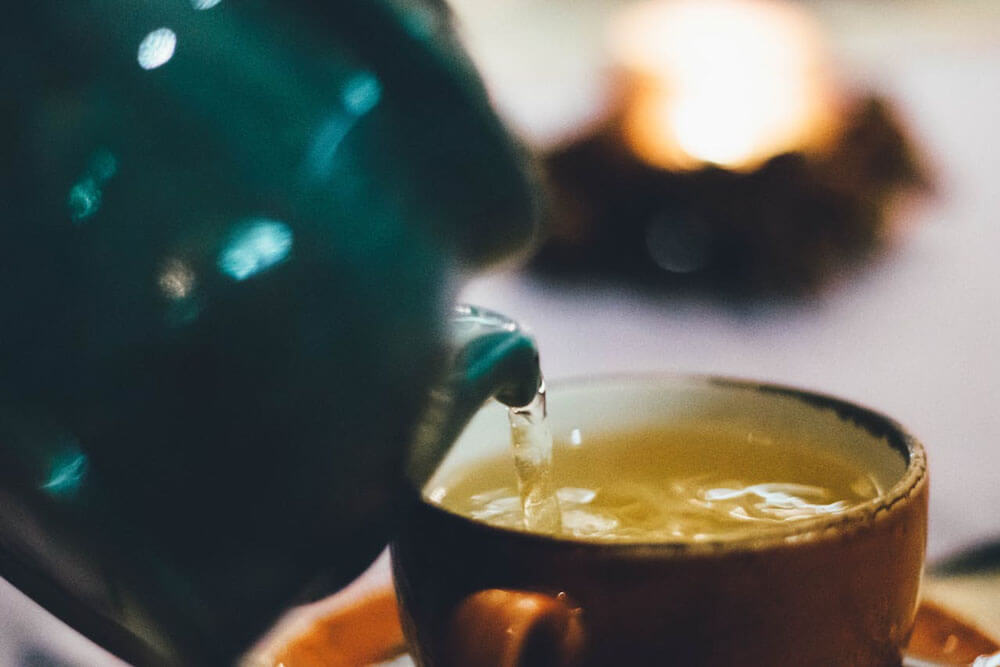L’exploration du monde de la cuisine chinoise dévoile une myriade de saveurs, d’arômes et de traditions profondément enracinées dans l’histoire. Au cœur de cette mosaïque culturelle se trouve une boisson humble mais omniprésente : le thé. Imprégné de siècles de tradition et de symbolisme, le thé occupe une place importante dans la gastronomie chinoise, offrant non seulement une boisson rafraîchissante, mais aussi un aperçu du riche patrimoine du pays.
Dans cet article de blog, nous plongeons dans le monde enchanteur du thé servi dans ces restaurants chinois, découvrant les diverses variétés, la signification culturelle et les étiquettes qui accompagnent cette boisson bien-aimée.
Les plus courants : Oolong, jasmin
Dans les restaurants chinois, les deux thés les plus couramment servis sont le Oolong et le Jasmin. Le thé Oolong, connu pour ses feuilles partiellement oxydées, offre un profil aromatique équilibré allant des notes florales aux notes fruitées, ce qui en fait un choix polyvalent pour accompagner divers plats. Le thé au Jasmin, quant à lui, infusé de délicates fleurs de jasmin, dégage un arôme parfumé et une douceur subtile, rehaussant l'expérience culinaire grâce à ses qualités apaisantes. Ces thés très appréciés non seulement éveillent les papilles gustatives, mais reflètent également le riche héritage culturel de la gastronomie chinoise.
Thé Oolong
Le thé Oolong occupe une place unique dans le monde du thé, car il subit un processus d'oxydation partielle, ce qui le place entre le thé vert et le thé noir en termes de saveur et de couleur. Cette oxydation partielle donne lieu à une gamme variée de saveurs, d'arômes et de couleurs, selon le degré d'oxydation et les méthodes de traitement employées. Les thés Oolong peuvent être légèrement floraux et herbacés ou profondément riches et torréfiés, offrant un spectre de goûts à explorer.

Sa polyvalence en fait un accompagnement idéal pour une grande variété de plats chinois, des plats de fruits de mer légers et délicats aux plats riches et savoureux à base de viande. Le thé Oolong est également réputé pour ses nombreux bienfaits pour la santé, notamment pour faciliter la digestion, favoriser la perte de poids et stimuler le métabolisme.
Thé au jasmin
Le thé au jasmin est apprécié pour son arôme captivant et sa saveur délicate, grâce à l'infusion de fleurs de jasmin pendant le processus de fabrication du thé. En général, les feuilles de thé vert servent de base au thé au jasmin, permettant au parfum floral du jasmin de compléter les notes herbacées et légèrement astringentes des feuilles de thé.
Le procédé de parfumage consiste à superposer des fleurs de jasmin avec des feuilles de thé, ce qui permet à ces dernières d'absorber l'essence florale au fil du temps. Le résultat est un thé au goût subtilement sucré et floral, rappelant les fleurs printanières. Au-delà de sa saveur délicieuse, le thé au jasmin est également apprécié pour ses propriétés calmantes et apaisantes, ce qui en fait un choix parfait à déguster après un repas ou lors de moments de détente.

Dans la culture chinoise, le thé Oolong et le thé au jasmin ont tous deux une signification symbolique et sont souvent associés à l'hospitalité, à l'amitié et à l'harmonie. Qu'ils soient dégustés seuls ou accompagnés d'un repas savoureux, ces thés offrent un aperçu de la riche mosaïque des traditions culinaires chinoises et continuent d'enchanter les amateurs de thé du monde entier par leur charme intemporel.
Comment juger ?
Pour juger le type de thé chinois, il faut généralement évaluer plusieurs caractéristiques clés, notamment la couleur, le parfum et la saveur. Voici comment vous pouvez évaluer le thé chinois en fonction de ces facteurs :
Couleur
- La couleur de la liqueur de thé (le liquide produit après l'infusion des feuilles de thé) peut fournir des indications précieuses sur le type de thé. Différents types de thé chinois présentent des couleurs distinctes en raison des variations de traitement et des niveaux d'oxydation.
- Les thés verts ont tendance à produire une liqueur jaune pâle ou jaune verdâtre.
- Les thés Oolong peuvent aller du jaune pâle à l’ambre ou même au brun rougeâtre, selon le degré d’oxydation.
- Les thés noirs produisent généralement une liqueur riche, brun rougeâtre ou brun foncé.
- Les thés blancs produisent souvent une liqueur jaune pâle très légère avec une légère touche verte.
Parfum
- L’arôme des feuilles sèches, ainsi que le thé infusé, peuvent donner des indices sur le type et la qualité du thé.
- Les thés verts ont souvent un arôme frais et herbacé avec des nuances végétales.
- Les thés Oolong peuvent présenter des notes florales, fruitées ou torréfiées, selon la variété spécifique.
- Les thés au jasmin sont appréciés pour leur parfum floral délicat, qui doit être prononcé mais pas trop fort.
- Les thés noirs présentent souvent des arômes maltés, terreux ou même fruités, parfois accompagnés de notes épicées ou sucrées.
- Les thés blancs ont généralement un arôme subtil et délicat avec des nuances florales ou fruitées.
Saveur
- Le profil aromatique du thé infusé est peut-être le facteur le plus important pour identifier son type.
- Les thés verts sont connus pour leurs saveurs fraîches et végétales, souvent accompagnées d'une douceur subtile et d'une légère astringence.
- Les thés Oolong offrent une gamme variée de saveurs, allant du floral et fruité au grillé et au noisette, avec différents niveaux de douceur et de complexité.
- Les thés au jasmin doivent avoir un goût délicat et floral avec une douceur subtile et une finale nette.
- Les thés noirs peuvent présenter des saveurs robustes et maltées avec des notes de caramel, de chocolat ou de fruits secs, ainsi qu'une sensation en bouche corsée.
- Les thés blancs sont appréciés pour leurs saveurs délicates et nuancées, qui peuvent inclure des notes florales, fruitées et mielleuses, souvent avec une douceur subtile et une finale rafraîchissante.
En observant attentivement la couleur, l'odeur et la saveur du thé, vous pourrez mieux apprécier ses caractéristiques uniques et mieux comprendre son type et sa qualité. La pratique et l'expérience sont essentielles pour affiner votre capacité à juger efficacement le thé chinois.
Les bonnes manières à table des Chinois
Les bonnes manières à table concernant le service et la consommation du thé chinois sont profondément ancrées dans la culture chinoise et sont souvent considérées comme un aspect important de l'étiquette sociale. Voici quelques règles de table essentielles à respecter lorsque vous dégustez du thé chinois :
1. Verser et recevoir le thé :
Lorsque vous servez du thé à d’autres personnes, tenez la théière d’une main et soutenez le couvercle de l’autre pour éviter qu’il ne tombe.
Versez du thé aux autres avant de vous servir vous-même en signe de respect.
Lorsque vous recevez du thé, tapotez légèrement la table avec vos doigts pour exprimer votre gratitude.
2. Tasses et soucoupes :
Tenez la tasse à thé par le bord ou par le fond pour éviter de chauffer toute la tasse.
Utilisez la soucoupe fournie pour récupérer les gouttes lorsque vous versez ou buvez du thé.
Évitez de faire tinter la tasse de thé contre la théière ou d’autres tasses, car cela est considéré comme impoli.
3. Geste de remerciement :
Après avoir reçu une recharge de thé, tapez doucement votre index et votre majeur (ou tous vos doigts ensemble) sur la table pour exprimer votre gratitude.
Ce geste reconnaît l'attention du serveur et constitue une manière polie de lui montrer sa reconnaissance.
4. Boire du thé :
Lorsque vous buvez du thé, soulevez la tasse à deux mains en signe de respect, en particulier lorsque vous recevez du thé d'une personne plus âgée ou d'un statut supérieur.
Buvez de petites gorgées plutôt que d’avaler le thé rapidement.
Évitez de souffler sur le thé pour le refroidir, car cela pourrait être interprété comme de l’impatience.
5. Étiquette de la théière :
Évitez de laisser la théière se vider, car il est considéré impoli de laisser des invités sans thé.
Remplissez la théière ou demandez plus de thé rapidement pour garantir que tout le monde dispose d'un approvisionnement continu.
6. Conversation et plaisir :
Les cérémonies du thé chinoises impliquent souvent conversation et détente, alors savourez le thé tout en participant à des discussions significatives avec vos compagnons.
Prenez le temps d’apprécier l’arôme, la saveur et la texture du thé, en savourant chaque gorgée.
7. Fin du repas :
À la fin du repas, il est de coutume d’exprimer sa gratitude à l’hôte pour le thé et l’hospitalité.
Proposez d’aider à servir le thé ou à nettoyer en signe de bonne volonté.
En observant ces bonnes manières à table, vous pouvez vous immerger pleinement dans la riche tradition culturelle entourant le thé chinois et montrer du respect à la fois pour le thé lui-même et pour vos collègues buveurs de thé.
Dialogue chinois courant sur la consommation de thé
Voici un dialogue chinois courant sur la consommation de thé, accompagné d'un pinyin pour vous guider dans la prononciation :
A : Est-ce que je peux me permettre de le faire ?
Nǐ xǐhuān hē shénme chá ?
B : 我喜欢喝绿茶,你呢?
Wǒ xǐhuān hē lǜchá, nǐ ne ?
R : Il s'agit d'une question de temps.
Wǒ xǐhuān hē wūlóng chá hé huāchá.
B : 乌龙茶有很多种类,你最喜欢哪一种?
Wūlóng chá yǒu hěnduō zhǒnglèi, nǐ zuì xǐhuān nǎ yī zhǒng ?
R : 我最喜欢铁观音,因为它有浓郁的香味和口感。
Wǒ zuì xǐhuān tiě guānyīn, yīnwèi tā yǒu nóngyù de xiāngwèi hé kǒugǎn.
B : 我也很喜欢铁观音,我们下次一起喝吧!
Wǒ yě hěn xǐhuān tiě guānyīn, wǒmen xià cì yīqǐ hē ba !
Traduction:
A : Quel genre de thé aimes-tu boire ?
B : J'aime boire du thé vert, et toi ?
R : J’aime boire du thé Oolong et du thé aux fleurs.
B : Il existe de nombreuses variétés de thé Oolong, laquelle préférez-vous ?
R : J’aime particulièrement le Tie Guan Yin car il a un arôme et une saveur riches.
B : J'aime aussi beaucoup le Tie Guan Yin. Buvons-le ensemble la prochaine fois !
Pour conclure
En conclusion, l'art de boire du thé dans la culture chinoise n'est pas seulement un choix de boisson, mais le reflet de préférences personnelles, d'un héritage culturel et d'interactions sociales. Nous avons découvert la diversité des thés appréciés par les individus, de la fraîcheur croquante du thé vert aux saveurs nuancées du Oolong et des thés aux fleurs comme le jasmin.
Chaque tasse raconte une histoire de tradition, d'artisanat et d'appréciation de la générosité de la nature. Que ce soit en sirotant une tasse parfumée de Tie Guan Yin ou en partageant une théière de thé vert avec des amis, l'expérience de boire du thé transcende le simple acte de s'hydrater, offrant des moments de tranquillité, de connexion et de célébration des plaisirs simples de la vie.
Alors, la prochaine fois que vous vous asseyez pour déguster une tasse de thé chinois, souvenez-vous de la riche mosaïque de culture et de tradition qui l’accompagne, et savourez chaque gorgée avec pleine conscience et gratitude.

